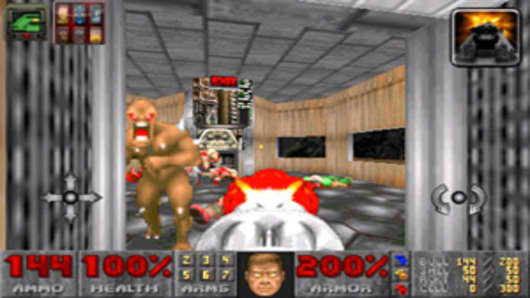John Carmack, co-creator of the “Doom” and “Quake” franchises, though, believes the time is coming when someone will spend $1 million or more to build an iPhone game.
“I wouldn’t be shocked if someone has one in development right now, though they probably don’t realize it will run that high yet,” he says. “If a title could do well at $9.99, you could put [Nintendo] DS level development expenses into it.”
While he’s best known for his work on PC games – and, more recently, traditional console systems—Carmack says the iPhone is where he’s having the most fun. He also sees Apple’s popular smartphone as the gaming system with the biggest potential for future growth.
It could, in fact, become the dominant portable gaming system, he says, relegating the Nintendo DS and Sony PSP to second and third place.
“I think mid- to long-term it’s a significant threat,” he says. “I don’t carry a DS or a PSP around, but I’ve got my iPhone everywhere. So if it plays good games, I’m less likely to pick one of the others up. ... I think the stars could align and it could start to eclipse those other systems in terms of unit sales.”
The market is a significant one. Nintendo has sold over 5.7 million DS hardware units in the U.S. this year, according to NPD Group. (The company offers two systems, which retail for $130 and $170.) Sony, meanwhile, has sold 1.4 million PSPs, most at or above $170. Games for both systems sell for $30 to $40 each.
Portable devices, in fact, are doing quite well against home consoles. The DS has consistently been the best selling video game hardware system since April 2009, beating the Wii, PS3 and Microsoft’s Xbox 360 by a wide margin.
Carmack’s id Software plans to release one iPhone game per quarter over the next year. It has just put out “Doom Classic,” a port of the seminal first-person shooter. Still to come are iPhone versions of “Quake” and a second “Doom” role-playing game. The company also hopes to have an iPhone version of “Rage” ready to release when it launches he new action franchise, likely in 2010.
Carmack’s best known for pushing the limits of computer graphics – something none of the previous iPhone ports have really done. And he’s getting itchy to flex his muscles.
“I’m probably going to work on some nifty, gee-whiz tech demo for the 3GS,” he says.
A Carmack graphical tour-de-force on the iPhone could further spike interest in the device as a gaming system (something Apple is actively trying to do). It could also put significant pressure on game publishers, such as Electronic Arts and Take Two Interactive Software to keep up. (And it might be enough to knock Activision off of the fence, convincing the company to begin creating iPhone titles.)
While he has enjoyed working on the iPhone, Carmack says he’s less eager to put together games for phones using Google’s Android operating system.
“I have mixed feelings about Android,” he says. “I‘ve got a warm feeling about the open source model, but a lot of the things that make Linux not-so-wonderful seem to be there in Android. On the iPhone, you know everyone on that device [has the same functionality and hardware], while on Android, you’re across the board on a number of different things. … The marketplace is also apparently not well handled. And from what I hear, nobody’s making a lot of money on these.”
id’s iPhone focus is becoming so concentrated, in fact, that the company is winding down its development of more traditional java and brew mobile titles. Games using those systems are actually more profitable than the ones the company makes for the iPhone, but Carmack often spars with the carriers over the limits they impose.
The headaches that come from that are ultimately not worth the money, he says.


